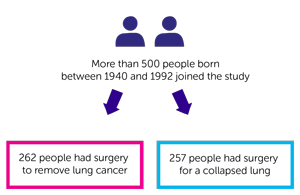A study to find out if people are still being exposed to the insulating material asbestos (TIPS)
Cancer type:
Status:
Phase:
The research team looked for fibres of asbestos in lung tissue samples from people having surgery. This study was supported by Cancer Research UK.
More about this trial
Pleural mesothelioma is a cancer that can develop in the lining of the lungs. The main cause is exposure to asbestos.
Asbestos is a material that was used in various things including building materials. It is made of tiny fibres which you can breathe in if you come into contact with it. These fibres irritate the cells and gradually cause damage. Over several decades, this can lead to cancer.
Asbestos is now banned in the UK, but some buildings still contain it. There is still some asbestos in the air in certain workplaces. And everyone is exposed to small amounts in the outside air.
The main aims of this study were to:
- find out how much asbestos the average person is breathing in
- work out how likely it is for a member of the general public to develop mesothelioma
Summary of results
The study team found that both exposure to asbestos and the risk of developing pleural mesothelioma are falling in the UK.
This study was open for people to join between 2005 and 2014, and the research team published the results in 2018.
About this study
The research team looked at samples of lung tissue from more than 500 people born between 1940 and 1992. Some had cancer, and some didn’t. But they all had an operation:
- 262 people had surgery to remove lung cancer
- 257 people had surgery for a collapsed lung
The team measured the number of asbestos fibres in samples of people’s lung tissue. They used that to calculate the risk of developing mesothelioma.
They also spoke to everyone who took part to find out where they worked, or had worked in the past. Some people had more ‘high risk’ jobs such as builders, carpenters or plumbers. People who had done these jobs in the past were often exposed to more asbestos.
Number of asbestos fibres
The research team measured the number of asbestos fibres per milligram (mg) of lung tissue.
They looked at whether the number of fibres in people’s lungs varied depending on when they were born. They found that the average number of fibres was higher in people who were born earlier.
Men born between:
- 1940 and 1944 had 62 fibres per mg
- 1960 and 1964 had 11 fibres per mg
- 1985 and 1992 had 1 fibre per mg
And women born between:
- 1940 and 1944 had 18 fibres per mg
- 1960 and 1964 had 9 fibres per mg
- 1985 and 1992 had 1 fibre per mg
They looked in more detail at people born between 1940 and 1964, and at the jobs they did. They found that people who worked as carpenters, plumbers, electricians and decorators had a higher number of asbestos fibres in their lungs.
Most people who were born after 1965 started work after asbestos use ended in the UK in the 1980s. The team looked at the jobs of people born after 1965 and found that:
- those working as plumbers, electricians and painters still had more asbestos fibres in their lungs, but much less than people born earlier
- carpenters had similar numbers of fibres to the general population
Risk of mesothelioma
There were about 2,700 new cases of mesothelioma diagnosed in the UK in 2017. The researchers predict that the risk of developing mesothelioma is at its peak and will now fall until about 2055. By then, people born before 1965 will be at least 90 years old.
The research team calculated the lifetime risk of developing mesothelioma for people born at different times. This means how likely it is that they will develop mesothelioma at some point during their life.
They found the risk is about:
- 1 in 10 for people born before 1965 who worked as carpenters
- 1 in 1,000 for people born before 1965 who did not work with asbestos
- 1 in 10,000 for people born after 1965
This means that mesothelioma is now becoming less common than many other cancers. The risk for people born after 1960 of developing lung cancer or bowel cancer, for example, is about 1 in 15.
The team estimate that by 2055, about 100 people per year will develop mesothelioma in the UK because they have been exposed to asbestos. And perhaps a similar number of people will develop mesothelioma which is not related to asbestos exposure.
Conclusion
The study team concluded that the average risk of developing mesothelioma will fall to about 1 in 10,000 people in the UK.
They suggest more work is done to find out whether the asbestos level in older buildings, particularly in schools, increases people’s risk. And to find out more about people’s risk in other countries.
Where this information comes from
We have based this summary on information from the research team. The information they sent us has been reviewed by independent specialists ( ) and published in a medical journal. The figures we quote above were provided by the trial team who did the research. We have not analysed the data ourselves.
) and published in a medical journal. The figures we quote above were provided by the trial team who did the research. We have not analysed the data ourselves.
Recruitment start:
Recruitment end:
How to join a clinical trial
Please note: In order to join a trial you will need to discuss it with your doctor, unless otherwise specified.
Chief Investigator
Professor Julian Peto
Supported by
British Lung Foundation
Cancer Research UK
Health and Safety Executive
NIHR Clinical Research Network: Cancer
If you have questions about the trial please contact our cancer information nurses
Freephone 0808 800 4040





